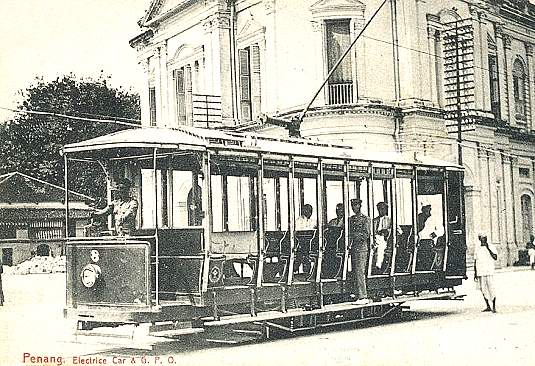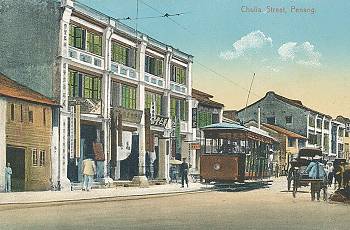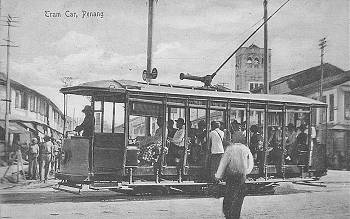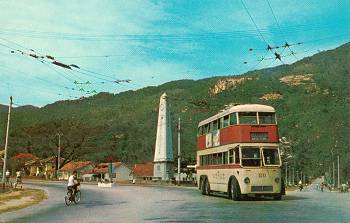

Our main postcard from Penang in Malaysia shows George Town Municipal Tramways Car 8 outside the General Post Office at Weld Quay about 1910. It was published by "Co-operative Agency, Straits Settlements" as No.3 in a set of Penang cards. The Straits Settlements comprised a number of individual settlements, including Penang on the north-west coast of the Malayan Peninsula. The Malay States and Straits Settlements were eventually incorporated into Malaysia in 1963, although Singapore became fully independent in 1965.
The first of the smaller views below shows car 14 in Chulia Street from an original photo by the German photographer August Kaulfuss. It is No.9 in a set from "S.M.Manicum, Penang", and on the back bears a trademark logo and the legend "Patronized by H.M. The King, Emperor of India". The second shows an unspecified tram at the Penang Road junction from a card by "M.J., Penang" but almost certainly printed in Germany. The final view shows trolleybus 20 (ex-London Transport 142) about 1958 by the Anti-War Memorial at the junction of Ayer Itam Road and Penang Hill Road. This is from a postcard by "P.M.S.M.N., Penang" and was printed in the U.S.A.
 The first tramway in George Town began in the mid 1880s and was a 7.5 mile long single track metre gauge line from The Jetty at Weld Quay to Ayer Itam Road, with a branch from the Prison to Waterfall Gardens which opened in 1885. It was initially worked by three Dick Kerr steam trams built in Kilmarnock, Scotland (named 'Penang', 'Jahore' and 'Sir Hugh Lowe', the latter named after a 19th-century English explorer of the region) and one from Kitson's of Leeds, England, this being one diverted from an order for Singapore. By 1890 this had increased to eleven locos. Kerr, Stewart was the contractor and operator for the company. Most of the tramway was built by the roadside with about 2.5 miles on the town's streets. In 1898 the company laid a tramway in the town from Magazine Road via Panang Road and Chulia Street to Weld Quay, which it worked with horse trams. In 1900 the company was bought by the Government and in the short term was leased to Robert Young, the company's former manager and engineer.
The first tramway in George Town began in the mid 1880s and was a 7.5 mile long single track metre gauge line from The Jetty at Weld Quay to Ayer Itam Road, with a branch from the Prison to Waterfall Gardens which opened in 1885. It was initially worked by three Dick Kerr steam trams built in Kilmarnock, Scotland (named 'Penang', 'Jahore' and 'Sir Hugh Lowe', the latter named after a 19th-century English explorer of the region) and one from Kitson's of Leeds, England, this being one diverted from an order for Singapore. By 1890 this had increased to eleven locos. Kerr, Stewart was the contractor and operator for the company. Most of the tramway was built by the roadside with about 2.5 miles on the town's streets. In 1898 the company laid a tramway in the town from Magazine Road via Panang Road and Chulia Street to Weld Quay, which it worked with horse trams. In 1900 the company was bought by the Government and in the short term was leased to Robert Young, the company's former manager and engineer.
In 1905 the George Town Municipal Tramways took over, re-laid tracks and electrified the line. From Jetty to the Prison, the site of the depot, it was now double track, with single track and passing loops from there to Ayer Itam and on the former horse tram route. The branch to Waterfall Gardens was abandoned. The line was inspected by the Commissioners on 21st December 1905 and opened to the public as far as the Prison on 1st January 1906 with the rest opening later that year, together with a new (mostly single track) route from Magazine Road to Jelutong. In 1923 a short branch shuttle line was opened from Ayer Itam to the lower station of the Penang Hill funicular railway, which opened in October that year and is still running today. This brought the electric tramway to its maximum extent of five miles of double and five miles of single metre gauge track.
 The original rolling stock was a batch of 14 cars from the Brush Electrical Engineering Company Limited of Loughborough, England. (right) They were to a design in common with other tropical tramways of the era, being single-deck, open-sided crossbench cars on 4-wheel trucks. The manufacturer's official photographs of car 2 show it having windscreens similar to Brush's standard product, but in service they were definitely open-fronted. It is believed that a second batch of similar cars, seven motor cars and three trailers, was later ordered from the United Electric Car Co. Ltd. of Preston, England, bringing the total fleet to 24 cars.
The original rolling stock was a batch of 14 cars from the Brush Electrical Engineering Company Limited of Loughborough, England. (right) They were to a design in common with other tropical tramways of the era, being single-deck, open-sided crossbench cars on 4-wheel trucks. The manufacturer's official photographs of car 2 show it having windscreens similar to Brush's standard product, but in service they were definitely open-fronted. It is believed that a second batch of similar cars, seven motor cars and three trailers, was later ordered from the United Electric Car Co. Ltd. of Preston, England, bringing the total fleet to 24 cars.
The period of the First World War took its toll on the infrastructure and by the 1920's tramway replacement was discussed. At first buses were considered, but in 1924 the first single-deck trolleybuses were ordered for trials and during the 1920's and 30's new routes were operated by vehicles from Ransomes, Sims & Jefferies Ltd. of Orwell Works Ipswich. In the 1930s the decision was made to replace the trams with new trolleybuses with the last tramcar officially running on 10th September 1936, although it is thought that the short shuttle to the Hill Railway continued with trams into early 1937. However, the street tracks on Weld Quay continued to be used by electric locomotives and goods trains of the Eastern Smelting Company until 1st January 1957.
 After the shortages of the Second World War, there were over 40 trolleybuses in service on four major routes at their peak in the 1950s. In 1956 five second-hand ex-London Transport C1 class double-deck trolleybuses, built by AEC in 1935, entered service. These became 20-24 in the George Town fleet being the former LT numbers 142 (left), 148, 175, 183, and 138. They had MCCW bodies except for 138, which was bodied by Weymann. They ran until the end of 1959. (See photo of 175 in London.) Despite the fact that much of the trolleybus fleet had been renewed with vehicles from Sunbeam in the 1950s, some as late as 1958, a political decision was taken to replace them by diesel buses. The last trolleybus ran on 31st July 1961.
After the shortages of the Second World War, there were over 40 trolleybuses in service on four major routes at their peak in the 1950s. In 1956 five second-hand ex-London Transport C1 class double-deck trolleybuses, built by AEC in 1935, entered service. These became 20-24 in the George Town fleet being the former LT numbers 142 (left), 148, 175, 183, and 138. They had MCCW bodies except for 138, which was bodied by Weymann. They ran until the end of 1959. (See photo of 175 in London.) Despite the fact that much of the trolleybus fleet had been renewed with vehicles from Sunbeam in the 1950s, some as late as 1958, a political decision was taken to replace them by diesel buses. The last trolleybus ran on 31st July 1961.
![]() Go to Postcard Of The Month Index
Go to Postcard Of The Month Index